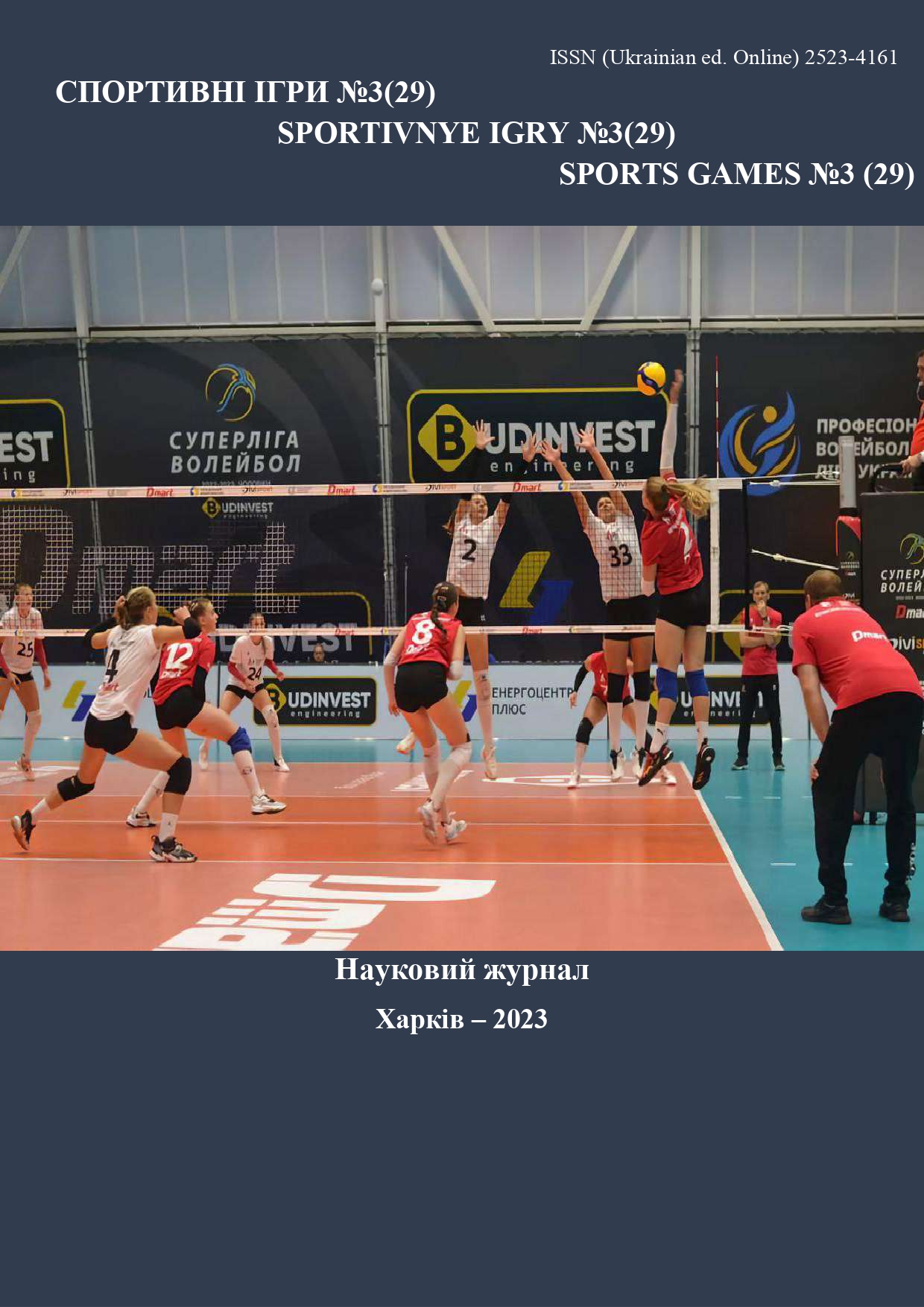Features of the manifestation of correlation relations between psycho-physiological indicators in groups of qualified basketball players
DOI:
https://doi.org/10.15391/si.2023-3.08Keywords:
components of athletes' success, qualified basketball players, neurodynamic characteristics, cognitive characteristics, cognitive-activity styles, polydependenceAbstract
In qualified sportsmen engaged in game sports, when a high level of training is achieved, the improvement of sports results can mainly be carried out due to the improvement of technical and tactical skills and accounting for the individual characteristics of psychophysiological functions, which allow to reveal and realize the internal reserves of the athlete without harming health. The purpose of the research is to establish correlations between the indicators of various psychophysiological states of qualified basketball players. Research was conducted using the Multipsychometer-05 computer complex. A group of qualified basketball players (n=13) was offered to perform a series of tests to determine neurodynamic and cognitive characteristics, current mental state using the color choice test, and activity-based genetically determined components of the success of qualified basketball players. According to the results of scientific research, it was found that a high level of anxiety inhibits the speed of the afferent part of the reaction; high performance and low level of fatigue contribute to the high-quality performance of the simple reaction test. The analysis of correlations between the balance of nervous processes and the current mental state of qualified basketball players showed that anxiety, as the first stage of stress manifestation, affects the optimization of perception and the quality of performance of the test for determining a complex reaction; the stability of the complex reaction depends on the level of anxiety and personal characteristics (concentricity, eccentricity and predominance of ergotropic/trophotropic tone) of the athlete; the dynamics of activation of the balance of nervous processes partly depends on the manifestation of working capacity, the degree of subjective feeling of comfort and dependence on external influences; the current mental state of the athlete affects the tendencies to anticipatory or delayed actions during the test for determining a complex reaction; when mastering the skills of performing a new task with influence from reduced work capacity and increased anxiety, compensatory mechanisms are involved; the current mental state has an impact on the speed of perception and processing of continuously incoming information; high speed of a simple visual-motor reaction has a positive effect on quantitative and qualitative indicators of cognitive activity and to some extent is involved in the formation of cognitive abilities of tested basketball players. Conclusions: neurodynamic characteristics that are genetically determined and that change little during ontogenesis have an impact on the formation of cognitive abilities and cognitive-activity styles of skilled basketball players.
References
Анікеєнко, Л.В. (2021). Особливості ігрової діяльності студенток-баскетболісток. Науковий часопис НПУ імені М. П. Драгоманова, 2 (130), 9-12. doi: 10.31392/NPU-nc.series 15.2021.2(130).01
Безмылов, Н.Н. (2010). Обоснование комплекса информативных показателей и определение их приоритетной значимости для отбора квалифицированных баскетболистов в команду. Физическое воспитание студентов, 2, 18–23.
Борисова, О., Нагорна, В., Шутова, С., & Митько, А. (2019). Модельні характеристики психофізіологічного стану висококваліфікованих спортсменів 7 у стресовій ситуації. Спортивна наука та здоров’я людини, 1(1), 4-9.
Горго, Ю.П., Чайченко, Г.М., & Маліков, М.В. (2005). Прикладна психофізіологія людини: Навчальний посібник для студентів вищих навчальних закладів. Запоріжжя: Запорізький національний університет.
Дьоміна, Ж.Г., & Чен Пен (2022). Зв ̓язок успішності навчання баскетболу з морфофункціональними та руховими показниками розвитку організму студентів. Науковий часопис Національного педагогічного університету імені М.П. Драгоманова, 3К (147) 22, 134-138.
Козина, Ж.Л, Ягелло, В, & Ягелло, М. (2015). Определение индивидуальных особенностей спортсменов с помощью математического моделирования и методов многомерного анализа. Педагогіка, психологія та медіко-біологічні проблеми фізичного виховання і спорту, 12, 41-50.
Коробейников, Г.В., Бейдж, М., Коробейникова, Л.Г., & Рааб, М. (2022). Психологическое состояние спортсменов высокой квалификации. Sport. Olimpism. Sănătate, 7, 422-426. DOI: https://doi.org/10.52449/soh22.67
Коробейніков, Г.В., Коробейнікова, Л.Г., Дудник, О.К., Іващенко, О.О., Міщенко, В.С., & Воронцов, А.В. (2017). Прояв нейродинамічного реагування у кваліфікованих спортсменів з різним рівнем стресостійкості. Вісник Чернігівського національного педагогічного університету. Серія: Педагогічні науки. Фізичне виховання та спорт, 147(1), 141-4.
Коробейников, Г.В., Турлыханов, Д.Б., Коробейникова, Л.Г., Никоноров, Д.М., & Воронцов, А. В. (2021). Контроль психофизиологического состояния борцов высокой квалификации. Теория и методика физической культуры, 3(65), 35-41. DOI: 10.48114/2306-5540_2021_3_35
Латишев, М.В., Квасниця, О.М., Спесивих, О.О., & Квасниця, І.М. (2019). Прогнозування: методи, критерії та спортивний результат. Спортивний вісник Придніпров’я, 1, 39-47.
Макаренко, М.В., & Лизогуб, В.С. (2011). Онтогенез психофізіологічних функцій людини. Черкаси: Вертикаль.
Прядко, Н.О. (2015). Мотивація досягнення як детермінанта успіху в професійній діяльності особистості. Вісник Чернігівського національного педагогічного університету, 127, 177–180.
Улан, А., & Шинкарук, О. (2019). Функціональна асиметрія у спорті:особливості прояву та підходи до використання в процесі орієнтації підготовки фехтувальників. Наука в олимпийском спорте. 1, 24-35. DOI:10.32652/olympic2019.1_1
Федорчук, С., Іваскевич, Д., & Борисова, О. (2020). Психофізіологічна характеристика стану спортсменів-гандболістів з різним рівнем мотивації до спортивного результату. Спортивна медицина, фізична терапія та ерготерапія, 1, 33-39. DOI: https://doi.org/10.32652/spmed.2020.1.33-39
Хекхаузен, Х. (2003). Мотивация и деятельность. Санкт-Петербург: Питер; Москва: Смысл.
Korobeinikova, L., Korobeynikov, G., Cynarski, W. J., Borysova, O, Kovalchuk, V, & Vorontsov, A. et al. (2020). Tactical Styles of Fighting and Functional Asymmetry of the Brain Among Elite Wrestlers. Ido Movement for Culture. Journal of Martial Arts Anthropology. 20(4), 24-30. DOI: 10.14589/ido.20.4.4
Hoffman, J.R., & Maresh, C.M. (2000). Physiology of basketball. In: Garrett WE Jr, Kirkendall DT, eds. Exercise and sport science. Philadelphia, PA: Lippincott Williams & Wilkins,: 733–744.
Sychev, V.S., Davydova, S.S., & Kashkarov, V.A. (2017). Functional asymmetry in sport. Theory and Practice of Physical Culture, 11, 23-3.
Vaez Mousavi, M., Mokhtari, P. (2022). Physiological Patterning of basketball free throws. Journal of Humanistic approach to sport and exercise studies (HASES), 2(3), 297-306.
Wu, Chuanzhong, Xu, Li, Korobeynikava, Lesia, Qiu, Xuhui, & Wang, Yangsong (2022). Construction of Structural Elements and Characteristic System of Athletes’ Cognitive Ability. Psychology Research, 12(5), 238-243.













